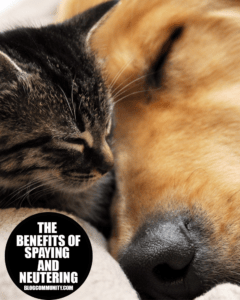To Spay and Neuter Your Pets
February Is National Pet Spay/Neuter Awareness Month.
About 2.7 million healthy, adoptable cats and dogs—about one every 11 seconds—are put down in U.S. shelters each year. Often these animals are the offspring of cherished family pets. Spaying and neutering your pets is a proven way to reduce pet overpopulation, ensuring that every pet has a family to love them.

Having pets altered is the number one way to stop pet overpopulation. Approximately 7.6 million companion animals enter animal shelters nationwide every year. Approximately 3.9 million are dogs and 3.4 million are cats and statistics indicate that cats are euthanized 10 to 1 over dogs.
Sadly, there just aren’t enough homes and animals end up in shelters for a variety of reasons: some are found on the street, others are rescued from cruelty situations and unfortunately many are given up by their families.
Spaying and neutering is the most effective and humane way to prevent animals from being born accidentally. Ultimately, these procedures save the lives of thousands of cats and dogs.
Benefits of Spay/Neutering for Your Pets
Your pet will live a longer healthier life if you have them spayed or neutered! We all know that spaying and neutering your pets is crucial to keep pet population under control, but did you know that there are also countless health benefits?
Spay/Neutering Reduces or Eliminates:
- Messy heat cycles in females.
- The tendency to bite, your pet will still be protective but less aggressive. (Aggression is different than protectiveness.)
- The extra expenses from an unexpected litter of puppies or kittens.
- Spraying, marking territory, or making inappropriate sexual approaches toward humans, objects or other animals.
- Spaying/neutering increases a dog’s life by an average of 1-3 years and a cat’s life by 3-5 years.
- Animals have less desire to roam, thus they’re less likely to become lost; therefore they are less likely to be injured in an auto accident. In fact, as many as 85% of dogs hit by cars are unaltered.
- An un-spayed dog is 12 times more likely to develop mammary tumors and nearly 50% of mammary tumors are malignant in dogs.
- An un-spayed cat is 7 times more likely to develop mammary tumors and nearly 90% of mammary tumors are malignant in cats.
- Neutering decreases incidence of prostate disease and eliminates risk of testicular cancer. Testicular tumors are the second most common tumor in male dogs.
So, as Bob Barker always said, “And remember folks, please be sure to spay and neuter your pets!”










My family just recently adopted a cat, and we are wanting to get it spayed. But before we put it through that we want to know that there are actual benefits to having this done. It’s good to know that if we were to do this then it will actually increase their lifespan by a few years. Which to us it would be nice to keep it around for a long time.